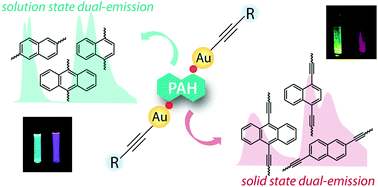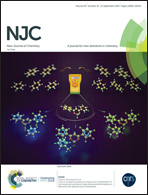Solution versus solid-state dual emission of the Au(i)-alkynyl diphosphine complexes via modification of polyaromatic spacers†
Abstract
Single molecule luminophores capable of multiple emissions are essential for the development of new materials with unconventional photophysical behavior. In this work, a family of diphosphine ligands PPh2–PAH–PPh2 with variable polyaromatic hydrocarbon (PAH) spacers (PAH = 9,10-anthracene L1, 1,4-naphthalene L2, 2,6-naphthalene L3, and their diethynyl congeners L4–L6) were employed to prepare gold(I) complexes (RC2Au)PPh2–PAH–PPh2(AuC2R) (1–22), containing a selection of alkynyl groups. Investigation of their optical properties indicates that compounds with anthracene-based diphosphines (1–4 and 13–16) display only 1IL (ππ*) fluorescence with Φem up to 93%. The naphthalene and diethynyl-naphthalene diphosphine complexes (5–12 and 17–22), however, demonstrate panchromatic emission in the solid state and in solution featuring well-separated low and high energy signals, which originate from 1IL (ππ*) and 3IL (ππ*) transitions along with certain contribution from metal to ligand and ligand to ligand charge transfers.



 Please wait while we load your content...
Please wait while we load your content...